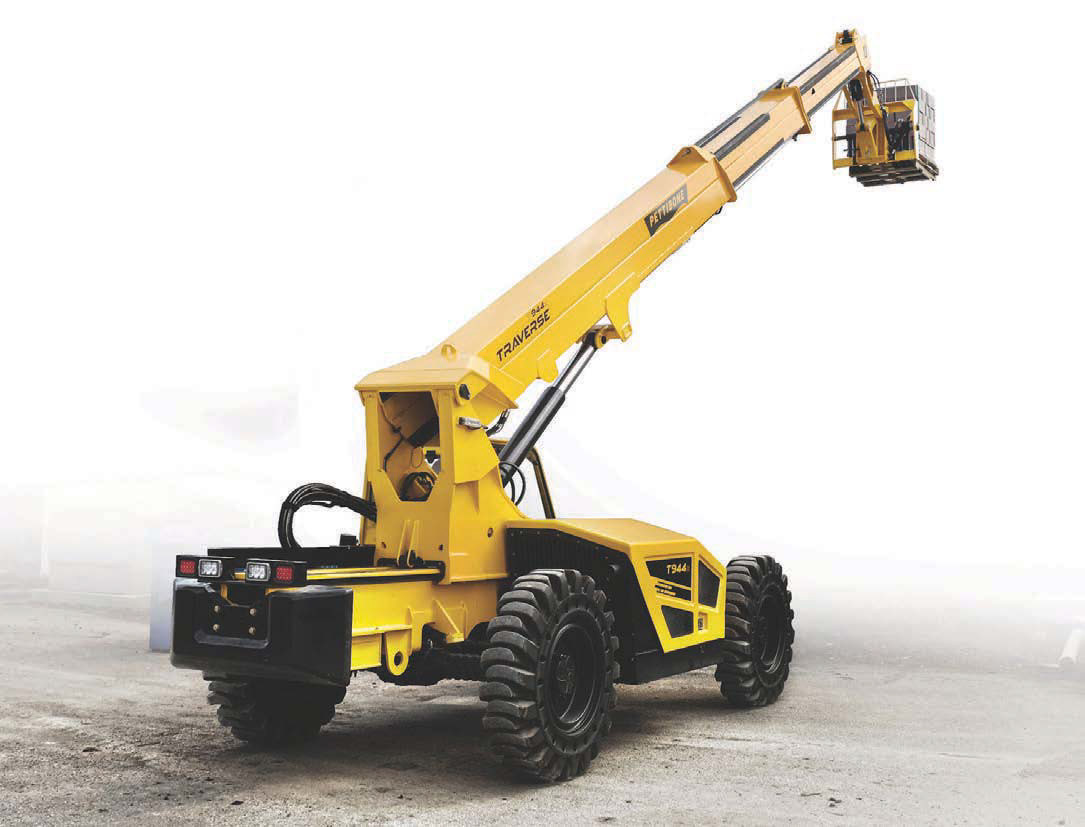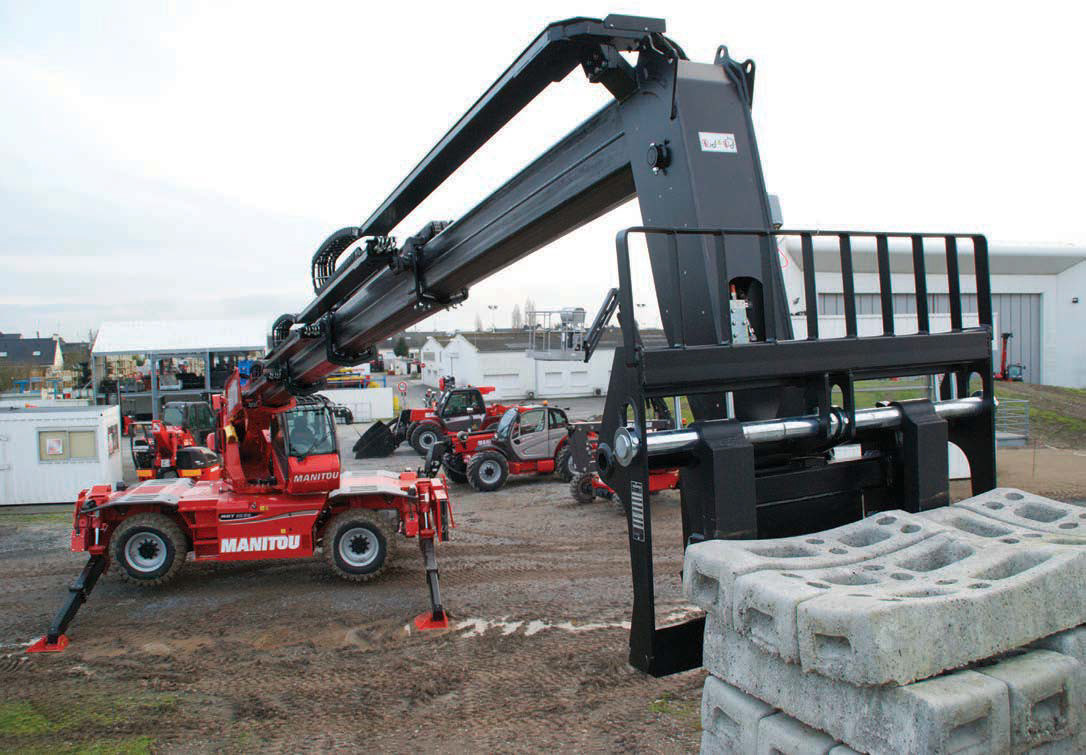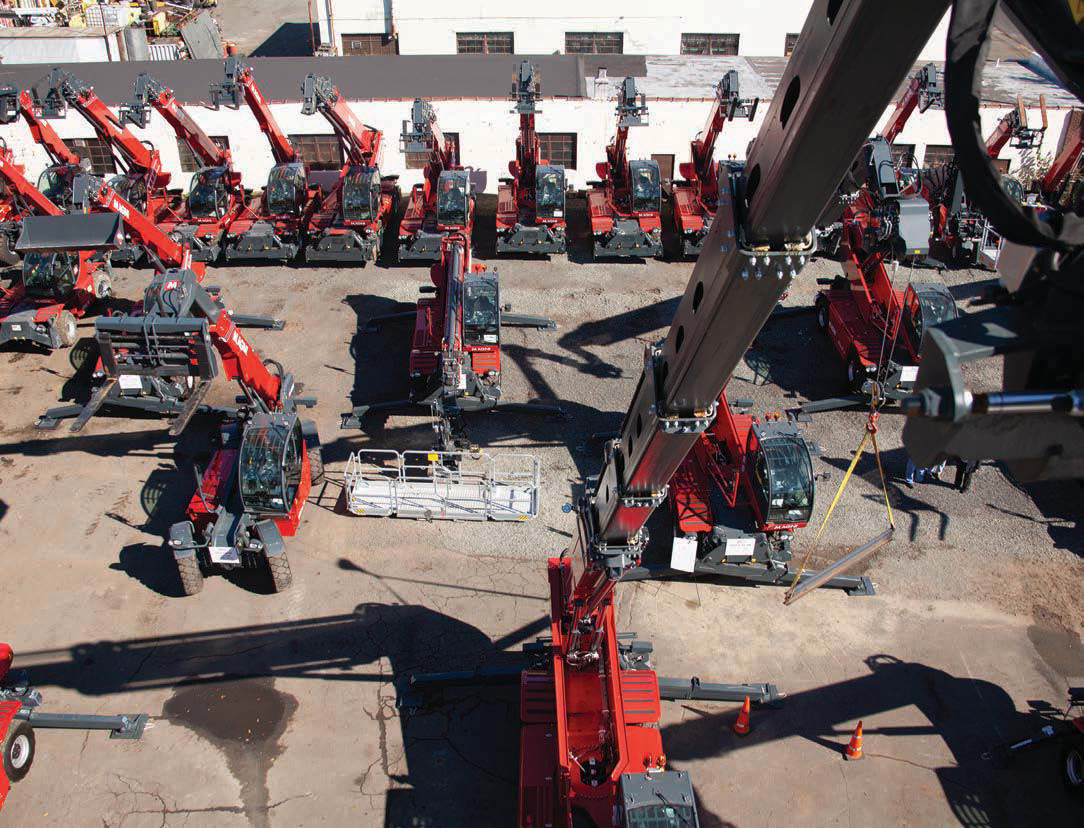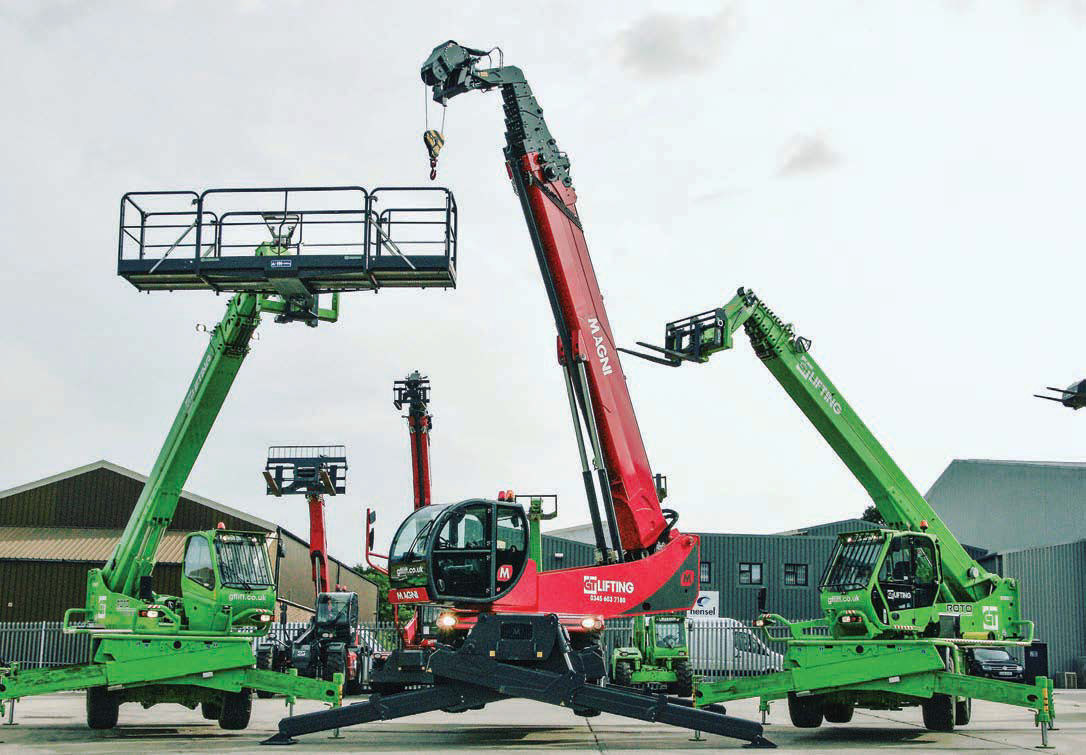Telehandlers rising!
21 January 2019Stuart Anderson, president of Chortsey Barr, looks at the increasing role for telehandlers, rather than traditional small mobile cranes, on many construction projects.
Small telescopic cranes mounted on rubber tyres of 30t or less capacity represent an ever-decreasing share of the global mobile crane market.
This is true in markets around the world irrespective of whether they are oriented towards all terrains, rough terrains or truck cranes. On the surface this trend seems to fly in direct contrast to demands for more compact, moremanoeuvrable and environmentallyfriendly machines. So, what’s happening?
Well there are two major factors. The first is the economics of crane manufacturing and ownership. Developments in steel technology as well as decades of crane manufacturing experience means that crane makers can get more performance from a particular size of crane, i.e. within its GVW and dimensions, than ever before. Bottom line cranes capacities and reach are always on an upward trajectory. Thus, in North America the smallest truck and rough terrain cranes in mainstream production are of 40USt (36t) capacity. In Japan the small 7t and 10t compact City Cranes are gone and the smallest in current production are 13t models. In Europe, the small Iron Fairy and Coles Speedcranes of 6–15t capacity are long gone while the smallest all terrains in mainstream production are 30–40-tonners. The fact is that over many years owners found that they couldn’t get a return from small mobile cranes since their fuel and operating costs were similar to those of much larger machines.
Obviously, by no way did this mean that there are no longer light loads to be lifted. The fact is that the handling of these loads transitioned from traditional mobile cranes to either smaller or more specialised lifting machines. In Europe and indeed in much of the world, truck-mounted knuckleboom loaders have taken much of this work. In North America boom trucks grew in capacity, reach and sophistication to replace conventional truck cranes. In Japan, city-type RTs remain a major factor but now the smallest in mainstream demand are of 13t capacity.
The popularity of other types of small crane has grown and mobile crane demand has diminished. In many countries mini telecrawlers of up to 6t capacity have become very popular for lifting in congested urban building sites. In addition, fast-erecting tower cranes, once a product only popular in Europe, have become more accepted on building sites around the world. None of these other types of crane are new to the market but their reach and capacity has increased with the result that they have eroded demand for small telescopic boom mobile cranes.
Crane buyers by their very nature are a conservative lot in their product choices—slow and reluctant to change. But another change is happening. Not surprisingly, inroads are being made by a product that has been around for quite some time—the telehandler. Now, if you look back through the annals of Cranes Today magazine, you’ll find the first indications of telehandlers starting to intrude into the ‘crane space’ some 20 years ago. Predictably it’s been a long journey but around the world this trend is now gaining momentum.
Telehandlers were first developed to replace high-reach varieties of mast-type rough terrain forklifts to allow loads of bricks and clocks to be raised for four- and five-storey buildings. They first emerged in the US in the early 1970s with Pettibone and Koehring the pioneers. In 1977 JCB changed the direction of the industry with its first ‘Loadall’ offering not just fork attachments but also materials handling buckets and crane jibs that could be quickly interchanged. By the mid-1990s there were some 36 telehandler manufacturers, equally divided between European and American companies and global demand had reached over 25,000 units per year.
By the turn of the millennium telehandlers had found a ready market not just in construction but also in agricultural applications. A broad range of applications demanded a wide range of sizes and variations. A large percentage of machines sold had 4x4 wheel drive with 4x4 wheel steer also very popular. Most machines sold in North America were of larger dimensions and the operator sat in an open seat. Most machines sold in the European market featured enclosed cabs and were more compact. Maximum lift heights varied from as low as 6m up to a maximum of 20m but relatively few machines offering greater than 17m reach were sold. Maximum lifting capacities ranged between 2.5 and 4.5t (5,500 and 10,000lbs) but at full elevation lifting capacities reduced to a range of 1 to 2.5t. As such, while telehandlers became popular for pick-and-carry work around construction sites, their lifting height didn’t generally compete with mobile or small tower cranes.
The first telehandlers to truly intrude in the ‘crane space’ came with the introduction by Italy’s Merlo of its first ‘Roto’ (360-degree swing) telehandler in 1991. That first model was still limited in capacity (2.5t maximum) and height (11m maximum) but it already had all the characteristics of a small rough terrain crane—outriggers at both ends, an enclosed swing cab, 4x4x4 wheel drive/steer options, and a full range of attachments including not only a fork carriage but also ‘quickchange’ crane jibs, man baskets, digging buckets, etc. The following year, the rough terrain forklift market leader—Manitou—introduced its first MRT Series rotating telehandler made at its Italian subsidiary and in 1994 another Italian manufacturer, Italmacchine, introduced its first Girolift.
By the end of the 1990s, larger rotating telehandlers of 4–5t maximum capacity and with maximum reach heights of up to 22m had been introduced. These machines were already effective alternatives to cranes in certain applications and crane lifting performance safety was assured by the installation of full LMIs similar to those used on mobile cranes. At first demand for rotating telehandlers was concentrated in Europe. Another fast-growing Italian telehandler manufacturer—wDieci—extended its line with the first of its ‘Pegasus’ series of rotating telehandlers in 1999. The market was further broadened when Terex acquired Italmacchine in 1998—later placing it within its Genie division which was acquired in late 2002. Another ‘big player’, Bobcat, acquired France’s Sambron in 2000. Caterpillar had been in the telehandler business since the late 1980s via a marketing arrangement with the UK’s DJB Industries but Cat’s product line didn’t and still has not extended to rotating machines.
A big step forward was made in 2003 when Manitou’s Italian subsidiary, Manitou Consuzione Industriali (MCI), introduced the largest rotating machine to date with its MRT 2540—the first in the 25m height class and with 4t maximum capacity. In 2005 Genie upped the ante once again with its Girolift GTH 6025R offering a maximum capacity of 6t and 25m maximum height, only to see Manitou launch its 30m height, 5t capacity MRT 3050 the following year.
Over recent years largedimensioned aerial work platforms have become an attractive and popular option on telehandlers of both rotating and fixed-frame types. Certainly, the versatility of being a ‘3-in-1’ machine is a key factor in the growing popularity of rotating telehandlers. Man baskets are amongst the most popular options, followed by crane jibs. Today’s machines are often equipped with attachment recognition systems and adaptive load recognition which recognizes stabilizer positions and sophisticated colour-coded in-cab display screens. Independent stabiliser (outrigger) beam extension and jacking enable the latest rotating telehandlers to be set up to an infinitely variable asymmetrical footprint. Although all telehandlers are restricted to top travel speeds of around 40km/hr and are not highway legal in most jurisdictions, self-levelling hydro-pneumatic suspension and tilting operators cab complete very comprehensive specification packages on the top-ofthe- line machines.
A relatively new market entrant— Magni—has also had a very positive influence on the development of the upper echelons of this market. Started in 2012 by Riccardo Magni, who had managed Manitou’s Italian operation for over 20-years, in a very-short period of time Magni introduced a broad range of models including the world’s largest rotating telehandler of 35m reach in 2014, followed by a 39m model in 2016 and a 46m model in 2017.
It is not as though Magni has the upper-levels all to itself, by any means. Manitou’s line now extends to the 31.5m MRT 3255 while Bauma 2016 saw Merlo, the inventor of the ‘Roto’ telehandler, pioneer their first ‘Hybrid’ models— the 34.1m Roto 45.35S Hybrid and 28m/6-tonne capacity Roto 60.28S Hybrid. Powered by a 55kw diesel coupled with a battery pack and electric motor, these new models introduce new levels of environmental-friendliness in terms of fuel consumption and emissions as well as being almost silent in operation.
Because most rotating telehandlers have been developed by manufacturers with a long tradition in rough terrain forklifts and small telehandlers, for the most part in Europe, they are marketed through dealers traditionally focussed on the forklift and access markets. Most telehandler manufacturers have their roots in the construction industry and as agricultural market demand for telehandlers developed, their manufacturers were forced to either enter into marketing agreements with farm machinery manufacturers or establish secondary dealer networks to meet the needs of the agricultural sector. However, to date, few handler manufacturers in Europe have chosen to partner with crane dealers. This is one of the reasons that many crane hire companies have not yet woken up to the potential of large, rotating telehandlers. In addition, two of the influential telehandler market leaders—JCB and JLG—do not yet offer their own rotating telehandlers.
While only a few of the larger European crane rental companies have telehandlers in their fleets, the crane market is beginning to recognise that there is a place in their fleets for rotating telehandlers. This ‘recognition’ is happening in North America faster than is the case in Europe. In part this is because crane US crane dealers have taken on the franchise for telehandlers and are more adept at explaining the benefits ‘in crane terms’ than forklift dealers.
In Europe it seems that crane rental companies based in the northern latitudes have been amongst the fastest to recognise the benefits of rotating telehandlers. Of the several Finnish companies to have developed fleets are the well-known J. Helaakoski and Sjoman companies. With a fleet of mainly Liebherr crawler and all terrain cranes up to the 750-tonne LTM 1750-9.1 the Helaakoski fleet includes both Manitou and Merlo roto machines. Meanwhile the Sjoman crane fleet consists mainly of Liebherr and Grove ATs topped by an LTM 1500. The Helsinki-based company established back in 1952 operates MRT Series Manitous ranging from the 18m/4t MRT 1840 to the 30m/5t MRT 3050. Meanwhile, Tallinn, Estonia-based Viking Cranes, which operates an exclusively Liebherr fleet of tower cranes and all terrains up to the 300t LTM 1300-6.2, has telehandlers including a Manitou 4t/25m MRT 2540.
Small-to-medium sized rental companies that focus on offering a broad range of so-called ‘lifting solutions’ have been quick to find a place in their machinery fleets for rotating telehandlers than crane hire companies exclusively devoted to say all terrain or tower cranes. One such company is Schelluinen, Netherlands-based Hoogwerkservice which operates a fleet with a large number of Jekko mini crawlers and fast-erecting tower cranes including Potain IGOs as well as Manitou MRTs ranging from the 4.5t /20.6m MRT 2145 to the 29.7m/5t MRT 3050—all of them equipped with crane jibs. The well-established South German crane rental company Knoll Kran recently augmented its fleet with the addition of two Magni RTH Series rotating telehandlers. They join a fleet that already included Merlo fixed-frame telehandlers, Liebherr and Grove all terrains to 250t capacity and Sennebogen and Liebherr telecrawler cranes.
While rotating telehandlers are a feature of many fleets of the large, specialist access and telehandler rental companies, so far, few UKbased crane hire companies have added this variety of machine to their fleets. It can be argued that smaller companies exhibit more flexibility in their product choices than the larger ‘more-disciplined’ rental companies. One particularly innovative company—Clark Lifting Solutions UK—is an example. Started in 2000 by crane industry veteran Mick Clark, the company operates from Cowfold, West Sussex near London Gatwick airport. Clark’s fleet is tailor-made to the needs of its local customers and includes a variety of Hitachi, Jekko, Maeda and Unic mini teleboom crawler cranes, Bocker aluminium trailer cranes and Merlo Rotos ranging from the 38.16 to the 6t capacity/23.9m model 60.24. Clark faces competition with another local company—Graham Trundle’s GT Lifting, based in Sinford, West Sussex. GT has made something of a speciality focusing on large-size rotating telehandlers with an impressive fleet of Merlo and Magni machines and is most notable for owning the top-of-the-line Magni 30m, 35m 39m and 46m models.
While now well-established in Europe, initially the rotating tele handler had difficulty developing North American demand. However, during the past four-to-five years customers have gradually recognised the merits and application/profit opportunities of these products. Manitou and Terex were amongst the first to attempt to cultivate this market and in 2012 Merlo appointed Applied Machinery based in North Carolina as its distributor. Arguably the most impact has been the 2015 US market entry of Magni with its line of the highest-reaching rotating telehandlers on the market.
The introduction of larger machines with lift heights of 20m-plus has been a major factor in the recognition of the merits of rotating telehandlers but another key contributor has been the appointment of crane dealers to market these machines. Back in 2013 Manitou made a big push to introduce its MRT rotating and MHT heavy-lift handlers to North American customers with its ‘Red Strategy’ tour demonstrating these machines to customers in cities coast-to-coast.
Today Manitou’s US dealer network includes H&E’s nationwide network as well as well-established crane dealers such as ALTA Equipment, Briggs Equipment, Custom Truck & Equipment, Kirby- Smith Machinery and Stevenson Sales & Service. The MRT 2150 Privelege has proved popular with the likes of Bay Crane while the large Manitou fleet of Jimmy Lomma’s New York Crane includes the top-of-the-line MTR 3255 offering 103ft (31.5m) lift height and 12,000lb (5,500kg) maximum fork capacity and 15,800lb maximum winch capacity.
Phillip Bisson, senior business development manager, Manitou Group said: “As the construction industry has bounced back from 2008’s financial crisis contractors are looking for ways to improve their productivity and profitability and tele handlers offer them this opportunity, especially if they require cranes on their jobsites. In the next 18 months I expect (North American) demand for rotating tele handlers to double as more and more contractors and customers are using this technology and realizing the benefits of having one unit performing the job of three or four others, we have seen quite an increase in sales and rentals throughout the network just over the last 12 months. Because the rotating telehandler can rotate 360-degrees with multiple attachments, operate on outriggers and with remote control, it offers many benefits that traditional telehandlers simply cannot match”.
Dieci is a relative newcomer to the American market having established its US subsidiary in 2014. Their vice president of sales, Brian de Paul agrees that the market was slow to develop “but we have seen that change over the past 12 months. They are becoming more commonly accepted throughout the country. I expect rapid growth in the rotating tele handler business over the next 18 months. They will become more accepted with more education of the benefits.”
Michel Robert, marketing manager of Manulift, Merlo’s Canadian distributor agrees: “The market [for rotos] will continue to grow, there is no turning back. It will take time but yes, I believe rotating telehandlers will be as popular in North America as they are in Europe. As time goes by and working space dimensions on jobsites becomes more congested, like in Europe, the need for compact units able to reach 60ft (18m) and more will grow and therefore rotating tele handlers will gain popularity.”
Syracuse, New York-based Empire Crane has become a major force marketing Magni in the Northeast. Paul Lonergan of Empire told Cranes Today that since taking on the franchise in 2013, sales of Magni have increased every year. “The larger machines have really hit the spot and our customers really love them. Earlier this year we added the latest RTH 6.30SH and RTH 6.35SH 30m and 35m machines to our fleet.”
Chicago’s Imperial Crane has also discovered the benefits of these machines. Al Lawson, sales manager, commented: “We are having people call us when they see one of our (rotating) Merlos on a jobsite. I think the overall use will undoubtedly increase as more of these machines are being used and end-users realize their true potential. Some of our customers have space limitations on the jobsite and cannot use a conventional tele handler as it needs more room to manoeuvre, while a rotating telehandler can offload a truck to exactly where its needs to go, whether it’s up in a structure or somewhere else on the site, while sitting on its outriggers— it does it faster than a conventional tele handler would while also being safer due to the fact that they are not driving around a jobsite.”
Similar comments were made by Kris Kasparek, general manager of All Aerials LLC, a division of All Erection & Crane Rental Corp., who said: “Construction methods have changed with more pre-fab units making telehandlers the more suitable option. It’s proving to be a cost-effective option for customers. Telehandlers are being used to set steel and pre-fab (housing) framing rather than small cranes and ATs”.
 Pettibone was one of the first telehandler manufacturers. Its latest model, the Traverse T944X features a boom system able to move back and forth on the carrier, allowing for positioning of loads through windows and in other tough-to-reach spots
Pettibone was one of the first telehandler manufacturers. Its latest model, the Traverse T944X features a boom system able to move back and forth on the carrier, allowing for positioning of loads through windows and in other tough-to-reach spots
 Chappy Corp uses a Magni RTH6.30 with a 72in fork carriage, supplied by Empire, in Chelsea, Massachusetts.
Chappy Corp uses a Magni RTH6.30 with a 72in fork carriage, supplied by Empire, in Chelsea, Massachusetts.


